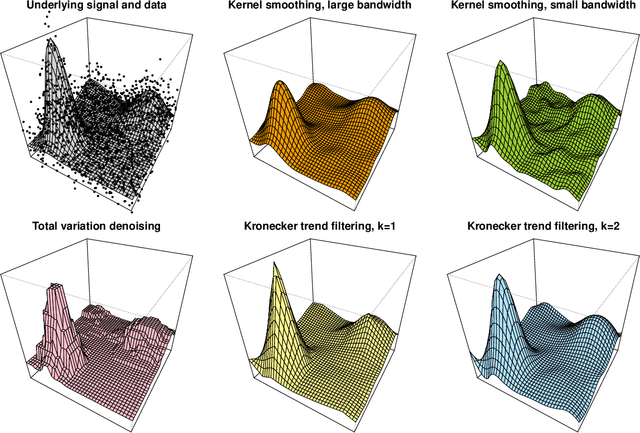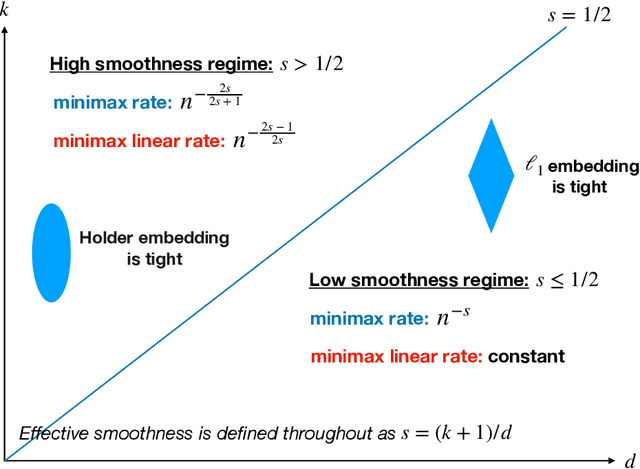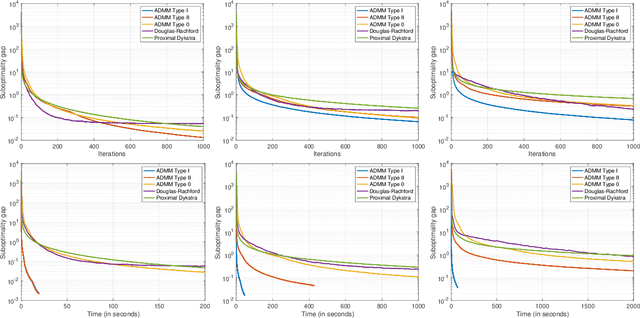Addison J. Hu
The Voronoigram: Minimax Estimation of Bounded Variation Functions From Scattered Data
Dec 30, 2022Abstract:We consider the problem of estimating a multivariate function $f_0$ of bounded variation (BV), from noisy observations $y_i = f_0(x_i) + z_i$ made at random design points $x_i \in \mathbb{R}^d$, $i=1,\ldots,n$. We study an estimator that forms the Voronoi diagram of the design points, and then solves an optimization problem that regularizes according to a certain discrete notion of total variation (TV): the sum of weighted absolute differences of parameters $\theta_i,\theta_j$ (which estimate the function values $f_0(x_i),f_0(x_j)$) at all neighboring cells $i,j$ in the Voronoi diagram. This is seen to be equivalent to a variational optimization problem that regularizes according to the usual continuum (measure-theoretic) notion of TV, once we restrict the domain to functions that are piecewise constant over the Voronoi diagram. The regression estimator under consideration hence performs (shrunken) local averaging over adaptively formed unions of Voronoi cells, and we refer to it as the Voronoigram, following the ideas in Koenker (2005), and drawing inspiration from Tukey's regressogram (Tukey, 1961). Our contributions in this paper span both the conceptual and theoretical frontiers: we discuss some of the unique properties of the Voronoigram in comparison to TV-regularized estimators that use other graph-based discretizations; we derive the asymptotic limit of the Voronoi TV functional; and we prove that the Voronoigram is minimax rate optimal (up to log factors) for estimating BV functions that are essentially bounded.
Multivariate Trend Filtering for Lattice Data
Dec 29, 2021



Abstract:We study a multivariate version of trend filtering, called Kronecker trend filtering or KTF, for the case in which the design points form a lattice in $d$ dimensions. KTF is a natural extension of univariate trend filtering (Steidl et al., 2006; Kim et al., 2009; Tibshirani, 2014), and is defined by minimizing a penalized least squares problem whose penalty term sums the absolute (higher-order) differences of the parameter to be estimated along each of the coordinate directions. The corresponding penalty operator can be written in terms of Kronecker products of univariate trend filtering penalty operators, hence the name Kronecker trend filtering. Equivalently, one can view KTF in terms of an $\ell_1$-penalized basis regression problem where the basis functions are tensor products of falling factorial functions, a piecewise polynomial (discrete spline) basis that underlies univariate trend filtering. This paper is a unification and extension of the results in Sadhanala et al. (2016, 2017). We develop a complete set of theoretical results that describe the behavior of $k^{\mathrm{th}}$ order Kronecker trend filtering in $d$ dimensions, for every $k \geq 0$ and $d \geq 1$. This reveals a number of interesting phenomena, including the dominance of KTF over linear smoothers in estimating heterogeneously smooth functions, and a phase transition at $d=2(k+1)$, a boundary past which (on the high dimension-to-smoothness side) linear smoothers fail to be consistent entirely. We also leverage recent results on discrete splines from Tibshirani (2020), in particular, discrete spline interpolation results that enable us to extend the KTF estimate to any off-lattice location in constant-time (independent of the size of the lattice $n$).
 Add to Chrome
Add to Chrome Add to Firefox
Add to Firefox Add to Edge
Add to Edge